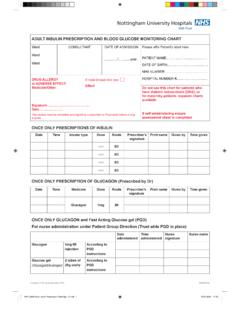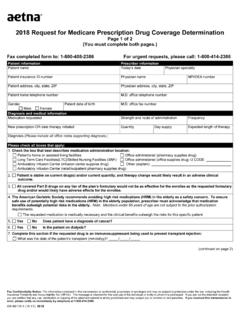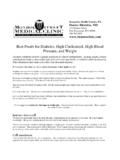Transcription of Hyperglycaemic Hyperosmolar States in Diabetes: …
1 Hyperglycaemic Hyperosmolar States in diabetes : Guidelines on Diabetic Ketoacidosis (DKA) and Hyperosmolar Non-ketotic Hyperglycaemia (HONK). Contents: Introduction .. 2. Diabetic 2. 3. Immediate 3. Further 3. Immediate 4. Intravenous fluids .. 4. 4. Intravenous insulin .. 4. insulin sliding 5. Nursing Care .. 5. Further 6. 6. Continuing 6. 7. 7. Immediate 8. Further 8. Immediate 8. Intravenous Fluids .. 9. 9. insulin sliding 9. Nursing Care .. 9. Potassium ..10. Further Continuing Contacting the DKA Summary ..12. Hyperglycaemic Hyperosmolar State Nursing Summary - The intensity of care depends on severity of DKA or HONK .. 1. 6) 1. 7) MONITORING / 1. 8) REVIEW .. 1. 10) ADMIN DETAIL .. i 11) INTRANET ii 1 HHS: DKA and HONK Guidelines Nick Oliver/ Carol Jairam March 2010.
2 Introduction Diabetic ketoacidosis (DKA) and Hyperosmolar non-ketotic hyperglycaemia (HONK) are Hyperglycaemic Hyperosmolar States and represent the acute Hyperglycaemic complications of diabetes . DKA is caused by absolute insulin deficiency and is usually seen in the context of type 1. diabetes . insulin deficiency leads to hyperglycaemia and a metabolic shift to alternative energy sources. Free fatty acids are metabolised to the ketone bodies beta-hydroxybutyrate and acetoacetate. Ketone bodies are weak acids and, in high concentrations can cause a significant acidosis and severe illness. DKA accounts for 14% of diabetes related hospital admissions. HONK is associated with insulin resistance and is most commonly seen in type 2 diabetes .
3 It is characterised by very high glucose concentrations and renal impairment with absent ketones. DKA is the classic decompensation state in type 1 diabetes but insulin deficient type 2. diabetes patients may also present with ketoacidosis, particularly African Caribbean patients. This is termed ketosis-prone type 2 diabetes or Flatbush diabetes , named after the area in New York where it was first described. DKA and HONK are both Hyperglycaemic States of decompensation in diabetes and may overlap. However, they require different management and are therefore considered separately in this guideline. Diabetic Ketoacidosis It is critical to exclude DKA in any unwell patient with diabetes . It is important to note that the magnitude of hyperglycaemia does not correlate with acidosis in DKA.
4 Precipitants of DKA are: Infection 30-40%. Non-compliance 25%. Inappropriate dose alteration 13%. Newly diagnosed diabetes 10-20%. Myocardial Infarction 1%. The mortality of DKA is 2-5% (higher in euglycaemic ketoacidosis), rising up to 50% in elderly patients. The majority of mortality and morbidity in DKA is attributable to delays in presentation and initiation of treatment. Rapid recognition and treatment of DKA is critical. DKA occurs due to insulin deficiency but it is not always associated with hyperglycaemia. DKA with a normal or near-normal glucose concentration is termed euglycaemic ketoacidosis. It is precipitated in circumstances where glycogen stores are exhausted such as protracted vomiting, alcohol use, malnourishment and pregnancy.
5 Euglycaemic ketoacidosis has a higher mortality than DKA with elevated glucose concentrations. 2 HHS: DKA and HONK Guidelines Nick Oliver/ Carol Jairam March 2010. Presentation History Patients with DKA may complain of: DKA Diagnosis: Nausea Vomiting Dehydration/ thirst Laboratory Glucose >11mmol/L. Polyuria pH< or Bicarbonate <20mmol/L. Abdominal pain Urine Ketones ++++. Headache (Capillary blood ketones > 1mmol/L). Blurred vision Weight loss Leg cramps Symptoms of any precipitant Examination Kussmaul respiration, Ketotic breath Dehydrated, hypotensive Abdominal tenderness (DKA may mimic an acute abdomen). Gastric stasis Decreased conscious level, confusion Features of the precipitant Immediate Investigations Establish Diagnosis Laboratory glucose Usually > 11mmol/L.
6 Blood gas (venous unless O2 saturations low). pH < Bicarbonate <20mmol/L. Urine dip Ketones +++ or above Others Urgent potassium, venous blood gas is acceptable Urea and electrolytes ECG. Further Investigations Chest X-ray (abdominal X-ray if tender or profuse vomiting). Full blood count CRP. Liver function Capillary blood ketone estimation (if available). Blood cultures Urine microscopy Pregnancy test Troponin 3 HHS: DKA and HONK Guidelines Nick Oliver/ Carol Jairam March 2010. Immediate Management Ensure airway, breathing and circulation are intact and support as appropriate Contact ITU early if severe DKA (pH< or HCO3<8mmol/L) or patient obtunded The central management of DKA is ensuring adequate fluid and insulin Intravenous fluids Patients with DKA may have a fluid deficit of over 6-8 litres Fluid status should be assessed clinically, biochemically and, if necessary, with central venous monitoring and a urinary catheter The initial fluid of choice is Saline with no potassium in 1st bag Rate of administration is dependent on hydration If serum sodium > 150mmol/L, consider Saline Once capillary blood glucose <12mmol/L, switch to 5% Dextrose.
7 Do not switch back to saline. If glucose concentration exceeds 12mmol/L, increase insulin sliding scale infusion rates If hypoglycaemia occurs, do not stop insulin infusion, switch to 10% dextrose and continue insulin as per sliding scale. Potassium Patients with DKA are usually 200-700 mEq deplete due to renal losses Despite overall deficit, the blood compartment may be hyperkalaemic due to insulin deficiency An urgent assessment of potassium is required (venous blood gas is acceptable) during the first 1litre bag of Saline Potassium usually starts in 2nd or 3rd litre of fluid and should be given in every bag thereafter Electrolytes must be checked a minimum of every 4 hours in the first 24. hours (venous blood gas electrolyte values may be used).
8 Ready-mixed IV infusion solutions should be prescribed and administered where possible Approximate guidance for fluid and potassium replacement in first 4 hours of DKA. This guidance must be adjusted according to clinical and biochemical status Time (Minutes) Fluid Potassium 30 1 litre Saline Nil 60 1 litre Saline Nil/ 20 mEq 120 1 litre Saline 20 mEq 240 1 litre Saline/ 20/ 40 mEq 5% Dextrose if glucose <12mmol/L. Intravenous insulin An intravenous sliding scale should be instituted immediately If any delay occurs in giving insulin sliding scale, 10 units of Actrapid may be given intramuscularly DKA is an insulin resistant state and patients may require large doses of insulin Sliding scale insulin should be continued until ketonuria has resolved and patient can eat and drink 4 HHS: DKA and HONK Guidelines Nick Oliver/ Carol Jairam March 2010.
9 If the patient normally takes insulin glargine (Lantus) or detemir (Levemir). subcutaneously continue this at the usual dose and usual time. Continuation of long acting analogues during the initial management of DKA provides background insulin when the IV insulin is discontinued. This avoids rebound hyperglycaemia when IV insulin is stopped and should avoid excess length of stay. This only applies to long acting analogues and does not obviate the need to give short acting insulin before discontinuing the intravenous insulin infusion. insulin sliding scale 50 units of Actrapid (soluble insulin ) in 50mls Saline (1 unit Actrapid in 1ml Normal Saline). Note that patients with a high BMI may have a large insulin requirement, sliding scales should be frequently reviewed and adjusted accordingly.
10 Initial infusion rates for DKA: Capillary Blood Glucose (mmol/L) Infusion rate (ml/hr). 1. 2. 3. 4. 20 6-8. Nursing Care 1. Set up 2 IV lines through a 3-way tap consisting of a non-return valve: 1st line: Make up 50 units Actrapid (soluble insulin ) in 50ml normal saline in a syringe driver 2nd line: Commence 1litre IV fluids (with or without KCl) through another pump 2. Check infusions against prescription with another trained nurse. 3. Document start of infusions on input/output chart and prescription chart 4. Explain need for infusions to patient and reassure that it is a temporary way to control glucose 5. Monitor capillary blood glucose levels 1 hourly until stable (capillary glucose 5 . 10mmol/L for 3 consecutive hours) and 2 hourly subsequently.





